List of stumbling blocks in Berlin-Grunewald
The list of stumbling blocks in Berlin-Grunewald contains the stumbling blocks in the Berlin district of Grunewald in the Charlottenburg-Wilmersdorf district , which remind of the fate of the people who were murdered, deported, expelled or driven to suicide under National Socialism. The columns in the table are self-explanatory. The table records a total of 47 stumbling blocks and is partially sortable; the basic sorting is done alphabetically according to the family name.
| image | Surname | Location | Laying date | information | ||
|---|---|---|---|---|---|---|

|
Minna Baad | Gneiststrasse 8 | Aug 21, 2006 | Minna Baad b. Bach was born on June 16, 1862 in Altenstadt (Bavaria). In Berlin, the widow lived in Grunewald at Gneiststrasse 8. The first name of her husband, who died before 1939, is unknown. Minna Baad, who had just turned 80, was deported from the Anhalter Bahnhof in Berlin on July 10, 1942 to the Theresienstadt ghetto on the same day as her housemate Jenny Michalski, which had been advertised to her and others as a "retirement home". On September 19, 1942, she was taken to the death camp in Treblinka. |
|
|

|
Artur Barasch | Wissmannstrasse 11 | May 21, 2008 | Artur Barasch, born on January 28, 1872 in Steinau, was murdered on April 6, 1942 in Sachsenhausen concentration camp . |
|
|

|
Elisabeth Bendix | Lynarstrasse 9 | March 20, 2012 | Actress, born on November 19, 1897 in Berlin as Elisabeth Bernhard. Married Otto Bendix on January 17, 1920. Converted to the Protestant faith in 1928. Deported to Riga at the end of November 1941 and murdered there on November 30, 1941 in the Rumbula forest . |
|
|

|
Otto Bendix | Lynarstrasse 9 | March 20, 2012 | Textile manufacturer, born January 25, 1883 in Berlin Mitte, presumably deported to Riga at the end of November 1941 and murdered there on November 30, 1941 in the Rumbula forest . |
|
|

|
Peter Bendix | Lynarstrasse 9 | March 20, 2012 | Born in January 1922, baptized Protestant in 1928. Son of Elisabeth and Otto Bendix. Shortly after his 17th birthday, his parents made it possible for him to leave for England. He escaped the Holocaust and only returned to Germany 6 years later as a member of the British armed forces . |
|
|
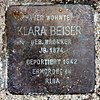
|
Klara Beiser | Gneiststrasse 8 | Aug 21, 2006 | Klara Beiser, b. Wronker was born on October 7, 1874 in Wolgast off the island of Usedom in Western Pomerania. She lived in Wilmersdorf in the Grunewald district at Gneiststrasse 8 and was relocated to the Prenzlauer Berg district (exact address unknown) shortly before the deportation. From there she was forcibly taken to the collection point in the former synagogue Levetzowstrasse 7-8. Her deportation to Riga (Latvia) took place on January 13, 1942 from the freight yard in Grunewald. There, despite her advanced age, she was initially admitted to the ghetto. Klara Beiser was murdered on December 31, 1944. | ||

|
Anna Berend | Paulsborner Strasse 42 | Oct 22, 2015 | Anna Berend was born on August 1, 1879 in Hanover. Artistically gifted, she took painting lessons from Leo von König and Dora Hitz, both members of the Berlin Secession. She was unmarried, taught handicrafts to children in the Charlottenburg youth center and lived with her brother Eduard Berend, whose household she ran, in Grunewald, on the second floor of a villa at Wangenheimstrasse 41. On December 4, 1938, Eduard Berend sent one from Sachsenhausen concentration camp Postcard to his sister Anna, in which he wrote of an "unavoidable emigration" to the USA or Sweden. This postcard was stamped on December 9, 1938, but Eduard Berend had been released from custody two days earlier. He managed to escape to Switzerland in December 1939. The then 63 year old Anna Berend lived in Grunewald for more than three years. On February 26, 1943, she and 1,095 people were deported from the Moabit freight station to the Auschwitz extermination camp, after having had to register at Grosse Hamburger Strasse 26, a former Jewish retirement home that was abused by the Gestapo for this purpose . |
|
|

|
Emmy Brown | Wallotstrasse 10 | July 17, 2007 | Emmy Braun, b. Grün, on April 22, 1882 in Berlin, was able to emigrate to Shanghai with her husband in 1940, where she died on December 24, 1943 in a ghetto set up by the Japanese . |
|
|

|
Georg Braun | Wallotstrasse 10 | July 17, 2007 | Georg Braun, b. on July 22, 1872 in Magdeburg, in 1940 he was able to emigrate to Shanghai with his wife. He died on March 29, 1941 as a result of the poor living conditions. Georg and Emmy Braun obtained permission to leave Germany when they were forced to sell their house to the “German Hunters' Association” in order to set up a Reichsjagdmuseum. |
|
|

|
Bronislawa hamburger | Richard-Strauss-Strasse 30 | Oct 6, 2016 | |||

|
Günther Dammann | Wissmannstrasse 17 | Oct 4, 2010 | Günther Dammann, b. March 8, 1910 in Berlin; Son of the banker Emil Dammann; since 1924 magician under the stage name "Robertini", pupil of the illusionist Chevalier Ernest Thorn (1855–1928); published his book Die Juden in der Zauberkunst in 1933 . He was deported to Riga on September 5, 1942, and murdered there on September 8, 1942. The stone was laid as the 1000th stumbling block in the Charlottenburg-Wilmersdorf district . |
|
|
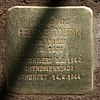
|
Helene Dobrin | Hagenstrasse 19 | 2nd July 2014 | Helene Dobrin, b. Leiser, who was born on August 18, 1878 in Leipzig, “a wonderfully pretty, blue-eyed woman”, who was called “Leni”, as passed down in the family. They had three children: Lily, Ruth and Max, who was born in 1911 and is Josie Dobrin's grandfather. Moritz and Helene Dobrin were deported to the Theresienstadt ghetto on August 5, 1942 from the Grunewald train station, just under a kilometer away. Helene Dobrin died there on April 14, 1944 from the terrible circumstances in the ghetto. Moritz Dobrin worked in the bakery and had bread, but could not look after his wife. After all, he was among the 1,200 lucky ones who arrived in Switzerland on a secret special transport from Theresienstadt on February 3, 1945. He went to his son Max and died in London on May 23, 1951. | ||

|
Isidore Dobrin | Koenigsallee 34 | March 20, 2012 | Isidor Dobrin, b. on November 22nd, 1876 in Schlochau (West Prussia), was the owner of the famous cafes and pastry shops on Jerusalemer Strasse and on Spandauer Brücke. He and his wife were deported to Auschwitz-Birkenau concentration camp on January 12, 1943, where they were immediately murdered. The children's book author Else Ury was in the same transport . The stumbling blocks were donated by grandson Jeremy Cohn. |
|
|

|
Moritz Dobrin | Hagenstrasse 19 | 2nd July 2014 | Moritz Dobrin was born on February 2, 1872 in Schlochau (West Prussia). His parents were named Philip, who was a horse dealer, and Minna, nee. Skull who had seven children. He was married to Helene Dobrin, b. Leiser, who was born in Leipzig on August 18, 1878. They had three children: Lily, Ruth and Max, who was born in 1911 and is Josie Dobrin's grandfather. Moritz Dobrin had been honored and honored in the First World War and thought he would remain untouched by the persecution of the Jews. Like his brother Isidore, he was active in the Jewish community. They were among the founding members of the synagogue in Grunewald and were members of the board of the Jewish old people's home in Berkaer Strasse in Grunewald. Both were bakers and confectioners, Moritz owned several shops (the first he had opened in 1896). Its six cafes, including one on Kurfürstendamm 202, were elegantly furnished and very popular with the Berlin population. In 1919 they bought a neat villa on Hagenstrasse in Grunewald that had previously belonged to the Charlottenburg bookseller Tränkel. The son Max had already been able to flee to London in the 1930s, where he and his wife Ida had two sons: Michael and Tony. Moritz and Helene Dobrin were deported to the Theresienstadt ghetto on August 5, 1942 from the Grunewald train station, just under a kilometer away. Helene Dobrin died there on April 14, 1944 from the terrible circumstances in the ghetto. Moritz Dobrin worked in the bakery and had bread, but could not look after his wife. After all, he was among the 1,200 lucky ones who arrived in Switzerland on a secret special transport from Theresienstadt on February 3, 1945. He went to his son Max and died in London on May 23, 1951. | ||

|
Rosalie Dobrin | Koenigsallee 34 | March 20, 2012 | Rosalie Dobrin, b. Goldschmidt, on November 15, 1886 in Tuchel (West Prussia). She and her husband were deported to Auschwitz-Birkenau concentration camp on January 12, 1943, where they were immediately murdered. |
|
|

|
Hugo Elkeles | Hubertusallee 8 | July 7, 2009 | Hugo Elkeles, born on May 31, 1896 in Posen, was a one-year-old volunteer in the war from 1914 and received the Ottoman Iron Crescent in addition to the Iron Cross . In 1922 he founded a timber business with his brother Julian Elkeles in Berlin-Weißensee . From 1933 he was repeatedly interrogated by the Gestapo and died on June 29, 1937 as a result of the abuse. His wife was able to flee to Palestine with three children in 1938 . |
|
|

|
Hans Ellstaetter | Toni-Lessler-Strasse 13 | 22 Sep 2013 | Hans Ellstaetter was born in Berlin on December 6, 1914. Shortly after the birth, he was taken over by the Jewish couple Toni and Dr. Karl Ellstaetter adopted and grew up in Grunewald at Seebergsteig 13-17 (now Toni-Lessler-Straße). After elementary school and high school, he went to boarding school “Le Rosey” in Switzerland in 1928. In 1931 he returned to Berlin and began commercial training at Daimler-Benz. Around 1933 the Ellstaetter family succeeded in obtaining Aryan certificates for Hans and the four years younger adoptive half-sister Eva. In 1935 Hans Ellstaetter started his service in the Wehrmacht. He was temporarily employed with the Condor Legion in the Spanish Civil War. There he met like-minded people who were active in the anonymous resistance. They met in Berlin in the sports club Sportkameraden (SK) and possibly also in the Grunewald Tennis Club (GTC). Hans Ellstaetter met Susanne Kreis, born on August 23, 1918 in Kolmar as the daughter of Fritz and Antonie Kreis, while doing sports. She had completed an apprenticeship at the Wilmersdorf Housekeeping School and was employed by Carl Duncker Verlag as an office specialist from 1936 to 1939. In 1939 Hans and Susanne Ellstaetter married. Together with other sports club members, they tried to help Jews who were in hiding and threatened with deportation. Eva Ellstaetter was also a member of this resistance group, as was sport and family friend Kurt Hansen, born on November 4, 1915 in Flensburg. After Hans Ellstaetter was deployed in various locations in the Wehrmacht, he was seconded to an aircraft engine factory in Paris in 1940 that belonged to Daimler-Benz. During this time he commuted regularly between Paris and Berlin and used this opportunity for courier services and to smuggle valuables such as jewelry, money and documents of persecuted Jews out of the country, often sewn into military coats. These resistance activities were exposed, presumably Hans Ellstaetter was denounced. He was drafted again on February 1, 1942 and transferred to the Eastern Front as a non-commissioned officer. There he fell on April 5, 1942 near Smolensk. | ||

|
Susanne Ellstaetter | Toni-Lessler-Strasse 13 | 22 Sep 2013 | Susanne Kreis, born on August 23, 1918 in Kolmar as the daughter of Fritz and Antonie Kreis. She had completed an apprenticeship at the Wilmersdorf Housekeeping School and was employed by Carl Duncker Verlag as an office specialist from 1936 to 1939. In 1939 Hans and Susanne Ellstaetter married. Susanne Ellstaetter continued to work in the anonymous resistance. The frequent entries in the calendar 1942/43 “Sport, Sport, Sport” indicate that she continued to use the contacts in the club for prohibited activities. Their two children Sybille and Jutta were looked after by their grandmother. Kurt Hansen, who belonged to this group, was stationed as a corporal with the 22nd Motorized Company in the Air Intelligence Supply Regiment in Zehlendorf. In a letter to Susanne Ellstaetter dated July 22, 1943, he wrote: “… By the way, something seems to be brewing against me, because today I am supposed to be questioned about something, I don't know about what. I just know that you want to make a big deal out of it ... "The letter ended:" At least there could be a possibility that I still need you seriously. "
What happened afterwards is not recorded. In any case, the pressure apparently increased and the friends realized the hopelessness of their situation. On October 4, 1943, they met for the last time in the apartment at Schöppinger Strasse 2 - probably with the intention of parting their lives together. Kurt Hansen first shot Susanne Ellstaetter and then himself. The Secret State Police (Gestapo) sealed the apartment immediately after they died, so the danger was acute. Eva Poch, geb. Ellstaetter, was present when Susanne Ellstaetter's body was buried on a cemetery wall in Gesundbrunnen; a grave site could not be found shortly afterwards. There is no further evidence for the life-threatening resistance activities of Hans and Susanne Ellstaetter, since it was a secret and nameless resistance group that operated with aliases and camouflage addresses and whose actions can only be reconstructed from a few sources. “Nobody has ever asked anything. There was a cloak of silence over the organization, ”Eva Ellstaetter recalled. |
||

|
Frieda Fraenkel | Gillweg corner Hubertusallee | Oct 22, 2015 | Frieda Fränkel was born on April 18, 1873 in Berlin. Unfortunately, I don't know what her parents were called. In the family it is said that they were called "the butter franks" and that they were considered well-off. Frieda Fränkel's brothers fought for Germany in World War I and were awarded the Iron Cross for this. Both were able to flee from the National Socialists and emigrate. Frieda Fränkel wanted to stay in Germany, she said: “You don't transplant an old tree.” Frieda Fränkel remained unmarried. She was a painter and - so it is said in the family - was the only woman allowed to copy the Dutch masters in the Berlin Kaiser-Friedrich-Museum, today's Bode-Museum.
Several of their works are owned by our family. |
||

|
Robert Graetz | Erdener Strasse 13 | April 16, 2013 |
|
||

|
Clara Hammerstein | Delbrückstrasse 17 | May 15, 2014 | |||

|
Adolf Hanau | Delbrückstrasse 19 | May 15, 2014 | |||

|
Else Hanau | Delbrückstrasse 19 | May 15, 2014 | |||

|
Martha Hirsch | Koenigsallee 35 | 28 Sep 2016 | |||

|
Otto Hirsch | Koenigsallee 35 | 28 Sep 2016 | |||
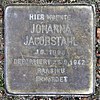
|
Johanna Jacobsthal (labeled as Johanna Jacobstahl) |
Douglasstrasse 11 | Aug 21, 2006 | Johanna Jacobsthal, born on August 19, 1896 in Berlin, was deported to Raasiku in Estonia on September 26, 1942 with over a thousand other Jewish people, including 108 children under the age of 10, and murdered there. Only 26 people from this transport survived the war. |
|
|
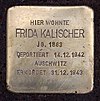
|
Frida Kalischer | At the Grunewald train station 10 | Oct 15, 2014 | |||

|
Bertha Landsberg | Hubertusallee 69 | May 30, 2018 | |||

|
Elsa Litten | Niersteiner Strasse 5 | March 23, 2014 | |||

|
Erika Litten | Niersteiner Strasse 5 | March 23, 2014 | |||

|
Use Litten | Niersteiner Strasse 5 | March 23, 2014 | |||

|
Lieselotte Litten | Niersteiner Strasse 5 | March 23, 2014 | |||

|
Paul Litten | Niersteiner Strasse 5 | March 23, 2014 | |||

|
Babette Mayer | Delbrückstrasse 19 | May 15, 2014 | |||

|
Salomea Meyer | Richard-Strauss-Strasse 30 | Oct 6, 2016 | |||

|
Jenny Michalski | Gneiststrasse 8 | Aug 21, 2006 | |||

|
Betty Nossen | Caspar-Theyß-Strasse 3 | June 12, 2009 | Betty Landsberger was born on March 16, 1871 in Posen to a Jewish family. She married the factory owner Leopold Nossen and moved with him to Berlin. Their son Herbert Ludwig Walter was born on September 9, 1895, followed by their daughter Anne-Marie Ilse on January 31, 1897. Her husband Leopold owned a company Nossen & Co., a mechanical factory for silk lining materials and a Gloria factory at Reinickendorfer Strasse 56. The family lived in Kronenstrasse in Mitte at the end of the 19th century and at the beginning of the next century at 11 Holsteiner Ufer in Tiergarten. Another daughter, Stephanie Elisabeth, was born there in January 1905. Leopold Nossen was economically successful, he bought the house at Caspar-Theyß-Straße 3 in Grunewald, where the family then also moved. The son Herbert became a doctor, he also worked as a writer, in 1930 he married Luise Hammer, the marriage was later divorced. Stephanie, who called herself Steffi, ran a school for gymnastics and dance in Bismarckstrasse 1. Leopold Nossen died in the mid-1920s, his wife Betty inherited the house at Caspar-Theyß-Strasse 3. In 1935, their son Herbert emigrated with his wife in the USA, Anne-Marie came to England and was interned there, Steffi emigrated to the USA in 1935 and opened a dance studio. Steffi Nossen, she married Peter Haendler. Betty Nossen had to move out of the house at Caspar-Theyß-Straße 3, in 1939 she lived at Regensburger Straße 14 in the rear building on the first floor. The house at Caspar-Theyß-Straße was pressed from her, in 1940 the tax authorities were already in the address book as the owner. On September 25, 1942, she was deported from Sächsische Strasse 2 to Theresienstadt, where she was murdered on February 11, 1943. The cause of death was given: marasmus, old age. |
|
|

|
Alfred Rotter | Kunz-Buntschuh-Strasse 16 | June 28, 2011 | Alfred Rotter, b. November 14, 1886 as Alfred Schaie in Leipzig and his brother Fritz were among the most famous and successful Berlin theater directors of the Weimar Republic. After the bankruptcy of the Rotter Group, he moved to Liechtenstein with his wife Gertrud and his brother Fritz , where they were killed in an attempted kidnapping on April 5, 1933 by the National Socialists Franz Roeckle , Rudolf Schädler , Peter Rheinberger and Eugen Frommelt. The perpetrators were charged in Vaduz, but they all received only a light sentence. |
|
|
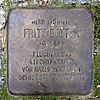
|
Fritz Rotter | Kunz-Buntschuh-Strasse 16 | June 28, 2011 | Fritze Rotter, b. September 3, 1888 as Fritz Schaie in Leipzig, and his brother Alfred were among the best known and most successful Berlin theater directors of the Weimar Republic. After the bankruptcy of the Rotter Group, he moved to Liechtenstein with his brother and his wife , but they negotiated with the Central District Court to return at the end of January 1933, which was ruled out after the Nazis came to power. He was able to escape the kidnapping attempt that killed his brother and wife. He died on October 7, 1939, in Colmar prison , where he had ended up with a bad check. |
|
|
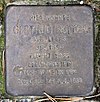
|
Gertrud Rotter | Kunz-Buntschuh-Strasse 16 | June 28, 2011 | Gertrud, b. Leers, born in 1894, went bankrupt with her husband Alfred and his brother Fritz in January 1933, first to Switzerland, then to Vaduz, where she was killed in an attempted kidnapping on April 5, 1933. |
|
|

|
Anna Samuel | Margaretenstrasse 2 | May 10, 2016 | |||

|
Cecilia Samuel | Margaretenstrasse 2 | May 10, 2016 | |||

|
Salomon Samuel | Margaretenstrasse 2 | May 10, 2016 | |||

|
Edith Saul | Richard-Strauss-Strasse 1 | Oct 10, 2017 | |||

|
Gertrud Saul | Richard-Strauss-Strasse 1 | Oct 10, 2017 | |||

|
Eva Weinmann | Richard-Strauss-Strasse 1 | Oct 22, 2015 |
|
||

|
Marie Wolff | Gneiststrasse 8 | Aug 21, 2006 |
Web links
- Stumbling blocks in Charlottenburg-Wilmersdorf - District Office Charlottenburg-Wilmersdorf of Berlin
Individual evidence
- ↑ a b c Stolpersteine Lynarstr. 9. In: Lexicon: Charlottenburg-Wilmersdorf from A to Z. District Office Charlottenburg-Wilmersdorf of Berlin, March 20, 2012, accessed on October 15, 2012 .
- ↑ Stolpersteine in Berlin. Klara Beiser, née Wronker
- ↑ a b Wallotstr. 10. In: Lexicon: Charlottenburg-Wilmersdorf from A to Z. District Office Charlottenburg-Wilmersdorf of Berlin, accessed on November 2, 2012 .
- ↑ Wissmannstrasse 17. In: Lexicon: Charlottenburg-Wilmersdorf from A to Z. District Office Charlottenburg-Wilmersdorf of Berlin, accessed on November 2, 2012 .
- ↑ a b Koenigsallee 34 / 34A. In: Lexicon: Charlottenburg-Wilmersdorf from A to Z. District Office Charlottenburg-Wilmersdorf of Berlin, accessed on November 2, 2012 .
- ↑ Konditorei Dobrin - all that's left is a spoon , at www.tagesspiegel.de
- ↑ Gillweg / Hubertusallee. In: Lexicon: Charlottenburg-Wilmersdorf from A to Z. District Office Charlottenburg-Wilmersdorf of Berlin, accessed on November 2, 2012 .
- ↑ Nossen, Betty , on bundesarchiv.de
- ↑ StA Berlin-Wilmersdorf HU 996/1930
- ↑ StA Berlin I, II, No. 125/1897
- ^ Nossen Betty: Obituary report, Ghetto Theresienstadt , on holocaust.cz
- ↑ a b c Kunz-Buntschuh-Str. 16-18. In: Lexicon: Charlottenburg-Wilmersdorf from A to Z. District Office Charlottenburg-Wilmersdorf of Berlin, accessed on November 2, 2012 .
